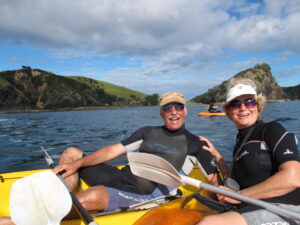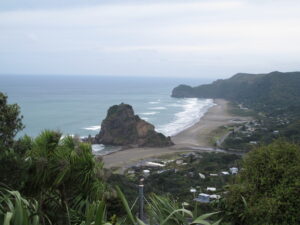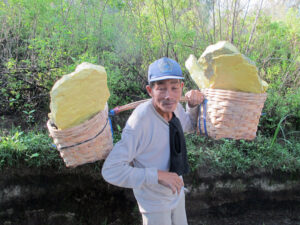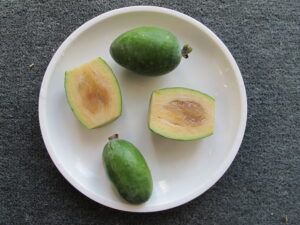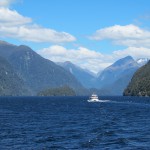
Since before the Europeans started to explore New Zealand, the vast southwest area of the South Island called Fjordland proved quite inhospitable. Captain Cook passed it by; the Spanish lit out for Australia after seeing it. Even the Maori here before them considered this land forbidding, one reason it was attractive to those who were not strong enough to conquer in tribal warfare. Other natives visited seasonally, but did not stay either.
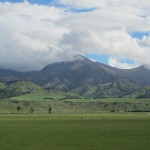
Fjordland consists mainly of glacial sounds, or long ocean inlets amid steep hills, with large bird populations and man-eating sandflies. Later Europeans tried to develop some of the land for ranching or farming but it defeated them all. Only in the broad valleys that drain from the small town of Te Anau southward and eastward to the bottom of the South Island could they prosper.
Because it is the end of the easily accessible landscape, therefore, Te Anau provides a front porch to Fjordland on its west as well as the dazzling mountain ranges and glacial lakes that teem in the area to its north.
So there’s a lot going on here. Even an hour hanging about the easy going, but upscale Town Centre – a melange of Italian restaurants, expensive venison meals, modest shops and souvenir goods – demonstrates its role as epicentre. Tour buses stream in; one afternoon, we saw four enter town within a few minutes of each other. In the morning, we saw dozens of other buses – from shuttle size to tour bus, some with Chinese markings, some with Korean, and some brightly decorated hiker transports.
Unlike Queenstown, however, itself a gateway to the rich outdoor activities of the mountains east of here, few stay long in Te Anau. Mostly the visitors flow in on these buses and then quickly flow out on other buses toward cruises on the Sounds and visits to the mountains or from them back to other towns. Fortunately, for Te Anau, it takes so long to get here from elsewhere – a minimum of three or four hours of driving to the nearest cities – that the transients stay for a bit at its lakefront hotels on the way in, the way out, or in-between activities. Then the people flow onward with yet more buses.
What are the attractions?

You can reach four of New Zealand’s best hikes or tracks – three or four day excursions up into the snow-peaked mountains, along the top of the world on skyline ridges and down into Edenic valleys. Around here you just need to mention the names of the tracks and you gather stories about someone’s passage along them, proud of accomplishing what you can only enjoy on foot.
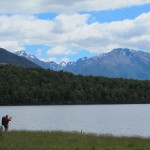
There’s the Hollyford, the Routeburn, which connects to it, and the Kepler, all of which open up to trekkers the high altitude splendor of the area. Then the Milford, the most famous, because of its similar charms and because of the unusual beauty of the Milford Sound where the track ends.
The latter three comprise the most concentrated collection of the nine Great Walks of New Zealand, a designation that ensures busloads continue to stream into Te Anau. They attract the fit and the willing, the well-off who use guide services and stay in virtual hotels on the track plus the money-starved backpackers who bed with 50 to 60 others on adjacent foam mattresses in Department of Conservation huts. Reservations at the huts or “hotels” during the walkable season from November to March fill up a year ahead on the Milford, and get tight months and months ahead on the others. We did the Routeburn three years ago, booking way in advance.
All the trekkers like us carry their necessities on their back, though you need not carry your own food on the guided hikes. So in town you see hordes of young and old hoisting packs nearly as large as themselves, willingly subservient to the weight of their goods. Some pack well: we spoke with two seasoned trekkers from Nevada who were only carrying 20 pounds each for three nights. Some try to outfit themselves as if they had burros for assistance: one girl was practicing how to walk straight along the hallway of our hostel after jamming cans of food and other supplies into her heavy pack.

Not all walk through here. The water attracts many others. Tour companies abound to take you along the road that winds its way into Milford Sound, where luxurious boats transport you into the magical waterway for a day, or two with an overnight. Doubtful Sound is quite lovely too and is catching up slowly to Milford’s reputation. (See our next post for the story of our Doubtful Sound cruise.) These cruises on the sounds are very popular with the tour bus passengers, for little effort is needed to get there other than enduring the long trip to Te Anau from other towns. Most visitors to New Zealand include one or both on their must-do checklist. But for now the numbers are controllable, and limit the potential tumult.

As for fresh water attractions, the massive glacial lakes of Te Anau and Manapouri, and nearby streams, offer outstanding fishing for the brown trout that were once introduced here but bred plentifully afterwards. The lakes offer other watersports – kayaking, jetskiing, boating, waterskiiing, etc. – though perhaps not so intensively as you would find on lakes more accessible to the population.

You can even join a guided tour to see the famous cave-dwelling glowworms, as we did. A tour boat traverses Lake Te Anou to dock near the end of a vast underground cavern. We walked just a small portion of the cavern along a metal scaffolding over a river and waterfalls coursing through it. Then in complete darkness and silence, we rafted through a passage spattered with galaxies of bluish-white points of light emitted by countless glowworms. Unforgettable.
These delights can seem like paradise to a visitor, so you would think that perfect weather is the norm here. Hardly. There are only five, maybe six, months a year when you can do any of the tracks due to snowfall. Even on the “fine” days, locals boast, four different seasons in a day can bring inclement conditions, especially lethal on the tracks where you need to be prepared for anything. Throughout the year, you get at least 200 days of rain on the Sounds, around 150 inches at the eastern end of Doubtful Sound and almost twice that up higher; fog is common. On the water, even on your expensive cruise, you never know what you’ll be able to see. Nancy hiked the whole Milford track and arrived at the Sound when you could hardly see anything. The locals encourage you to pray for rain because the steep slopes of these inlets then produce innumerable waterfalls; that’s making the most of reality here, but most tourists pray to have the relatively few sunny days.
Roads can be impassable even in summer, with the copious rainfall. The road to Doubtful Sound can be flooded from the streams it crosses. Right now the road to Milford Sound closes frequently because of complications resulting from a massive landslide that blocked the road last November. When something like that happens, cruise operators may need to helicopter people out of the Sound to get them back to civilization.

Despite all these challenges, people still want to come here. As a result, according to locals, a very different cloud is about to shroud the area. The government is moving rapidly on plans to build two shortcuts to the activities here. One is a new dedicated underground bus tunnel and roadway that would directly connect Queenstown to Milford Sound and the Milford-Hollyford-Routeburn Walks, cutting at least four tedious hours off the trip to them, and completely bypassing Te Anau. The other is a combination of boat, road and monorail that would zip people 20 kilometers north of Te Anau if they prefer the lakes and the sounds to start.
Clearly the merchants and hoteliers of Te Anau have a vested economic interest in fighting this plan. You won’t need them any more, or they would all have to move 20 kilometers north to survive. But they have a valid point about the environmental effects of the new roads and tunnels in themselves. And they understand that vastly increased numbers of people would likely descend on Milford and Doubtful Sounds, thereby ruining the special quality of solitude and escape which visitors now enjoy. Pressure for more extensive use of the trails would likely follow as well.
We sympathize with those who cannot manage to come here and experience this special place. We’re not sure about the direct environmental effects of the projects, but we’re pretty sure this area would change character considerably, becoming more commercial and less attractive, as a result.
Yesterday we left Te Anau on a shuttle bus to Invercargill, just like hundreds of others who were also leaving. On our return, we would love to find here again solitude in the wilderness and peace on the waters.
(For more pictures from New Zealand, CLICK HERE to view the slideshow at the end of the page.)



